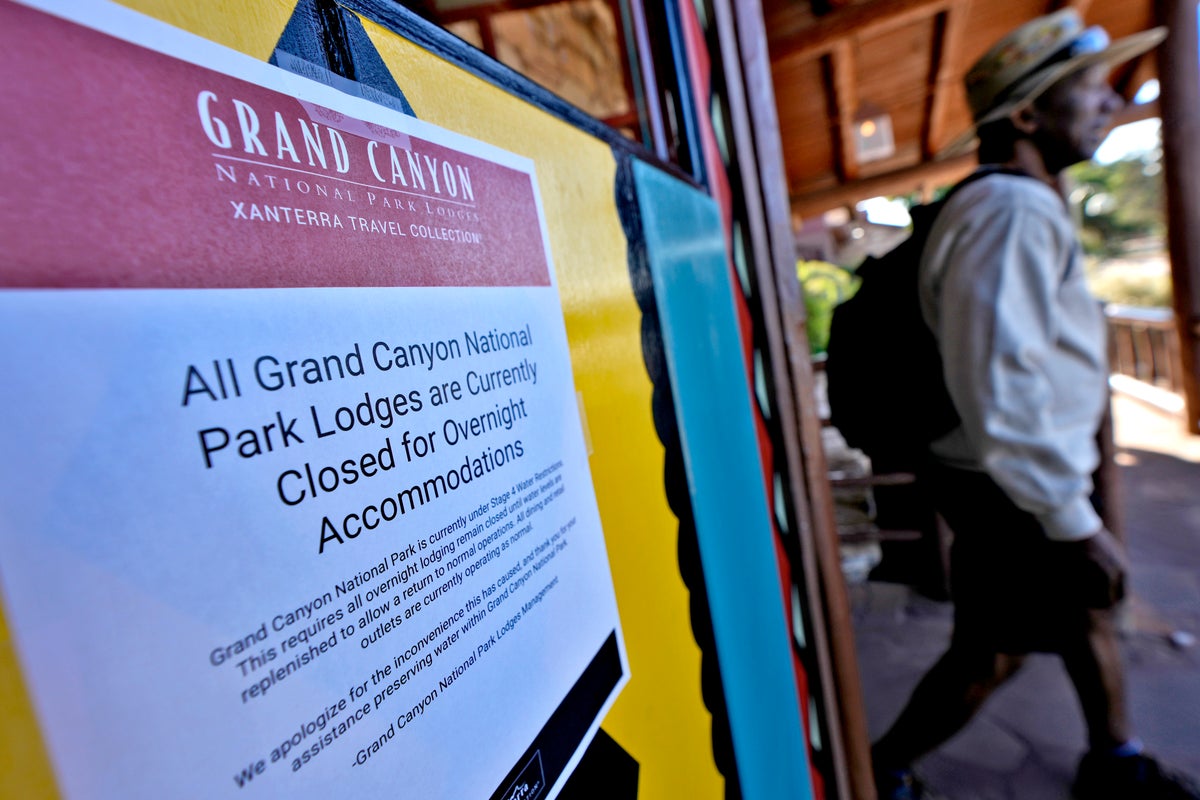
Support truly
independent journalism
Tourists staying at Grand Canyon National Park began moving to accommodations outside the park Thursday after water pipeline failures forced the sudden shutdown of overnight hotel stays during one of the busiest times of the year.
Water restrictions will run throughout the Labor Day holiday when hotels are near or at capacity. It’s an unprecedented outcome, even for a pipeline with a long history of frequent failures. Since July 8, the park has faced challenges with its water supply, and no water is currently being pumped to either the canyon’s south or north rims, officials said.
The 12.5 mile-long (20 kilometer-long) Transcanyon Waterline, originally built in the 1960s, supplies potable water for facilities on the South Rim and inner canyon. Park officials say it has exceeded its expected lifespan.
Since 2010, more than 85 major breaks have disrupted water delivery, but none have forced what park officials call “Stage 4” water restrictions. That is, until four recent significant breaks.
Under these water restrictions, visitors won't be able to stay overnight starting Thursday, including at El Tovar, Bright Angel Lodge, Maswik Lodge and Phantom Ranch.
At Yavapai Lodge, about 970 reservations for the weekend were canceled, according to spokesperson Glen White. Guests will be refunded for all deposits and payments, he said.
A spokesperson for Xanterra Travel Collection, which operates other affected hotels and lodging at the park, didn’t immediately respond to a request for comment.
Barbara Badger, who was visiting for two nights from Fontana, California, decided a few weeks ago to spend the first anniversary of her husband’s death at the Grand Canyon, a spot they visited together.
“We loved it. He loved it so much,” Badger said, tearing up as she spoke of her late husband, Douglas Badger. “We never hiked. We just drove around and looked at the beautiful scenery and took pictures of the animals and ate some nice food.”
She “decided to make an adventure out of it” and spend her second night at the campground after a sunset tour on Thursday evening. Badger said she was prepared to camp because not long after she made the reservation, a voice in her head told her to get a sleeping bag and some other gear, without knowing why.
“So I did all of that and, when I got here, I was prepared to camp out and with no reason why,” she said. “Except that’s just the way it worked.”
Hotels located outside the park in the town of Tusayan, Arizona, will not be impacted, and the park will remain open during the day.
Mark and Vicky Williams of London arrived at the park on Wednesday with their 15-month-old son and had planned to stay until Sunday. They got a refund for the nights when they won’t be staying at the hotel in the park, he said.
“We’ve had to rebook somewhere in Tusayan, which is good, but it’s not as good,” Mark Williams said, noting that they wanted to be close to the canyon to walk around the village easier. There wasn’t much choice at the last minute, he said.
“We did have to overpay quite a lot for somewhere that we probably wouldn’t have chosen to stay at,” he said. “But when you’ve got a kid, you just have to find somewhere.”
Carved by the Colorado River and known for its vast desert landscapes, the Grand Canyon welcomed nearly 523,000 visitors last August and more than 466,000 visitors last September.
Josh Coddington, communications director at the Arizona Office of Tourism, said he expects an uptick in calls from people wanting to know if they can visit the Grand Canyon.
“The Grand Canyon is known not only throughout the U.S., but throughout the world, and people love visiting it,” he said.
While the park isn’t entirely closed, any perception that it is could negatively impact the cities and towns where tourists sleep, shop and dine on their way to the canyon, including Flagstaff, Williams and Tusayan on the south side and Cameron on the east side.
Park officials hope to restore full operational status for overnight guests on the South Rim as quickly as possible.
Complicating restoration efforts, however, is that the breaks occurred in a narrow part of the canyon known as “the box," an area susceptible to rock fall and higher temperatures this time of the year. A photo of one of the recent breaks released by park officials shows a funnel of water spewing from the pipe and across the slim canyon.
“It's definitely a challenging place to be and have a pipeline break on you," Grand Canyon spokesperson Joelle Baird said, noting safety concerns for the crews tasked with repairing the damage.
The pipeline failure comes amid a $208 million rehabilitation project of the waterline by the National Park Service that began recently. Upgrades to the associated water delivery system are expected to be completed in 2027.
The park says it wants to meet water supply needs for 6 million annual visitors and its 2,500 year-round residents.







